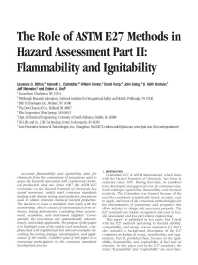Mining Publication: The Role of ASTM E27 Methods in Hazard Assessment: Part II - Flammability and Ignitability
Original creation date: March 2005
Accurate flammability and ignitability data for chemicals form the cornerstone of procedures used to assess the hazards associated with commercial chemical production and use. Since 1967, the ASTM E27 Committee on the Hazard Potential of Chemicals has issued numerous, widely used consensus standards dealing with diverse testing and predictive procedures used to obtain relevant chemical hazard properties. The decision to issue a standard rests solely with the membership, which consists of representatives from industry, testing laboratories, consulting firms, government, academia, and instrument suppliers. Consequently, the procedures are automatically relevant, timely, and widely applicable. This paper highlights some of the widely used standards, complemented with hypothetical but relevant examples describing the testing strategy, interpretation, and application of the results. A further goal of this paper is to encourage participation in the consensus standards development process. The paper is published in two parts. The first part (in the preceding issue of Process Safety Progress) dealt with the E27 standards pertaining to thermodynamics, thermal stability, and chemical compatibility. The second part, published here, focuses on the flammability, ignitability, and explosibility of fuel and air mixtures.
Authors: LG Britton, KL Cashdollar, W Fenlon, DJ Frurip, JE Going, BK Harrison, J Niemeier, EA Ural
Peer Reviewed Journal Article - March 2005
NIOSHTIC2 Number: 20026042
Process Saf Prog 2005 Mar 24(1):12-28
See Also
- Determining the Root Causes of Flame Cutting and Welding Fires in Underground U.S. Coal Mines
- Evaluation of the Bagged Stone Dust Barrier Effectiveness in a Bord and Pillar Mine
- Explosion Temperatures and Pressures of Metals and Other Elemental Dust Clouds
- Initial Study of Buried Communication Cable for Underground Mines
- Rapid (Grab) Sampling During Full-scale Explosions - Microscopic and Analytical Evaluation
- Reducing the Fire and Explosion Hazards of Flame-Cutting and Welding in Underground Coal Mines
- Refuge Chamber Expectations Training - 1.0
- Remotely Installed Mine Seals for Mine Fire Control
- A Review of Recent Accidents Involving Explosives Transport
- U.S. Bureau of Mines Technology Applicable to Disaster Response, Urban Search And Rescue
- Content source: National Institute for Occupational Safety and Health, Mining Program


 ShareCompartir
ShareCompartir
